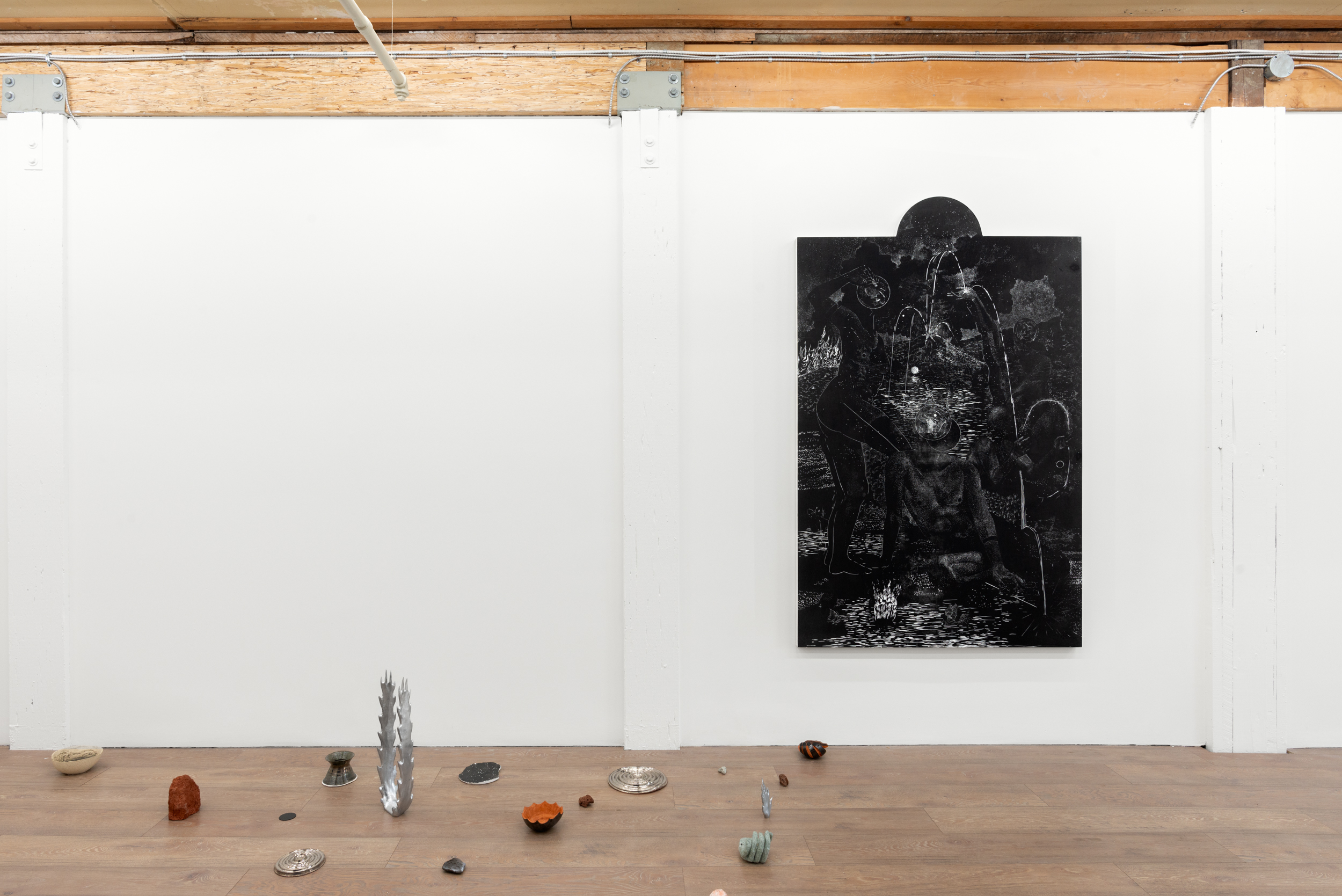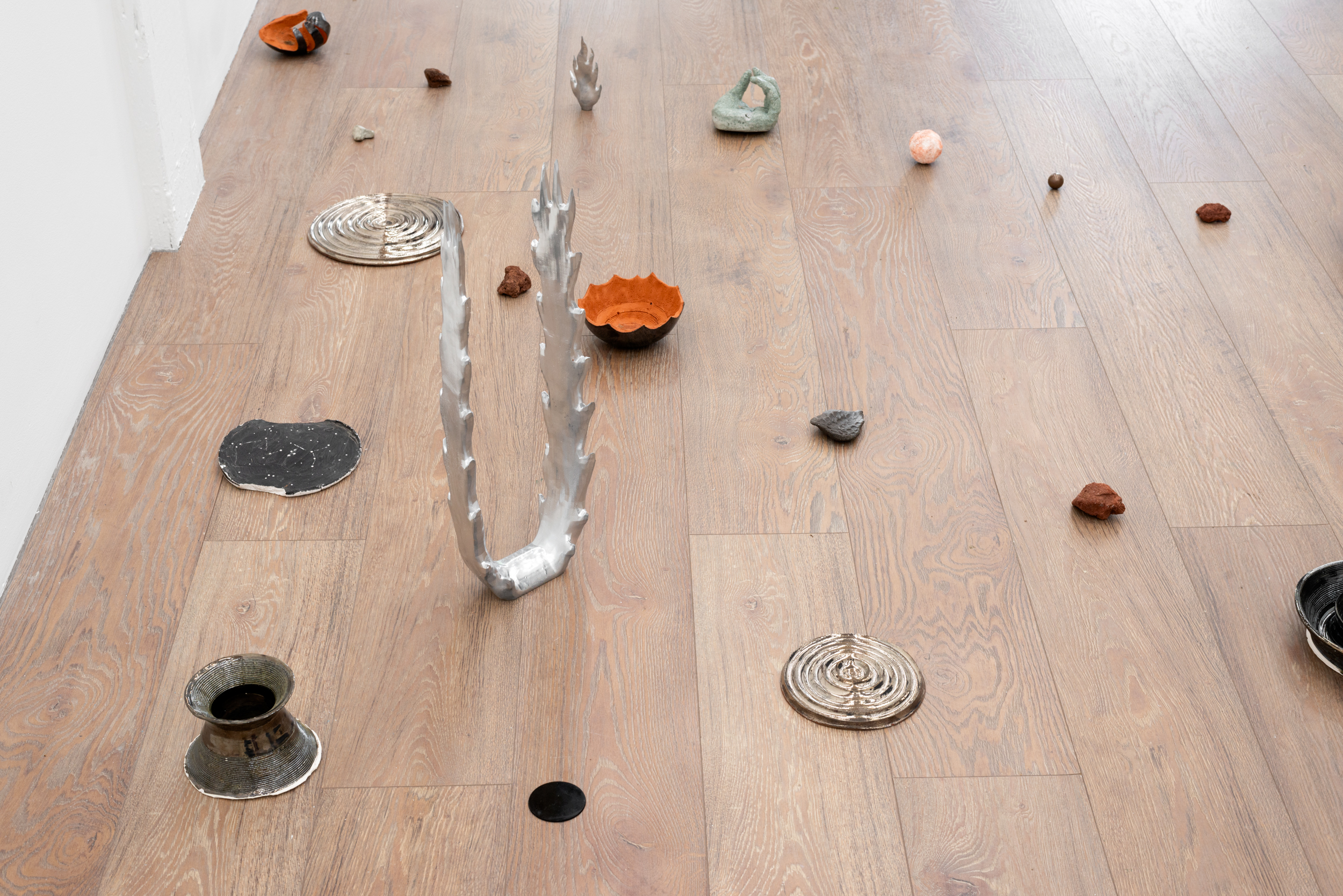


















Sergio Suárez: Aphelion
June 28–August 17, 2024
Exhibition Map
Pale Fire is proud to present Sergio Suárez’s first exhibition in Canada. The exhibition coincides with the earth reaching its farthest position from the sun in its orbital cycle. This occurs annually, roughly two weeks after the summer solstice. The phenomenon is called aphelion, a term composed of the ancient Greek words apo, for “far,” and helios, for “sun.” In Greek cosmology, Helios is the god of the sun and vision. He is an omniscient witness who oversees oaths, magic and spells.
Cosmology is a means of organizing human emplacement and connection in the universe. Philosopher Frederico Campagna has described it as a melodic line that imprints a sense of harmony onto the inherent cacophony of existence. Suárez is curious about the diverse melodies that people have composed throughout history. His compositions are densely saturated with icons, symbols and gestures that conjure the traditions of frescoes, mosaics and codices. His prints and installations produce encounters between visual lexicons that open up how these systems have been coded, metaphysically, socially and politically.
Suárez works extensively with woodblock printmaking—a craft that he refers to as “composing in time.” He employs minimal sketching and develops images slowly, through an accretion of marks. His confidence in image-making was nurtured through his training in geometry and drafting, acquired during his time studying aeronautical engineering. Air currents and electromagnetism introduced Suárez to how disciplines such as meteorology and physics give structure and narrative to intangible phenomena. This experience piqued his interest in other cultural and linguistic traditions that seek to articulate the means and meaning of planetary origins and functions.
The sun—as the primary source of light and heat, a measure of time and a marker of place—features in origin stories (called cosmogonies) from around the world. The Mexica cosmogony of the five suns, for example, organizes time into five cycles of creation and destruction, ruled by five sun gods. We reside in the epoch of the fifth sun, governed by the war-like god Tōnatiuh, whose reign is motivated by movement and whose demise is predicted to be caused by earthquakes.
Our era is governed by science and rationalism. Though predicated on the notion of a “stable truth,” these melodic lines are no more resolute than those that preceded or parallel them. At the limits of technical perception and empirical reason is an edge that may open up onto other melodic lines, such as the echo of Tōnatiuh’s rage or Helios’s spells. Suárez’s matrices are the imaginal architectures(as Campagna calls artworks) that invite us to encounter existence at the limits of ocular vision, where a form of insight—perhaps akin to the omniscience of the sun— invites us to enter the magic of being.
Sergio Suárez (b. 1995) was born in Mexico City and is based in Atlanta, Georgia. His practice spans printmaking, sculpture, painting and installation and is informed by baroque intricacy, theological iconography and traces of Mesoamerican material cultures. Suárez’s work has been exhibited in Atlanta at Whitespace Gallery, Day & Night Projects, THE END Project Space, the Consulate General of Mexico in Atlanta and Atlanta Contemporary. Internationally, he has show at the Woolwich Contemporary Print Fair in London, England; Haugesund International Relief Print Festival in Norway; Oped Space in Tokyo, Japan; and Ionian Center for the Arts and Culture in Metaxata, Greece. Suárez is the recipient of grants from the Nexus Fund and Idea Capital, as well as residencies with the Bemis Center for Contemporary Art in Omaha, Nebraska; the Studios at MASS MoCA in North Adams, Massachusetts; Stove Works in Chattanooga, Tennessee; and the Skowhegan School of Painting and Sculpture in Maine. Suárez studied drawing, painting and printmaking at the Ernest G. Welch School of Art and Design in Atlanta.